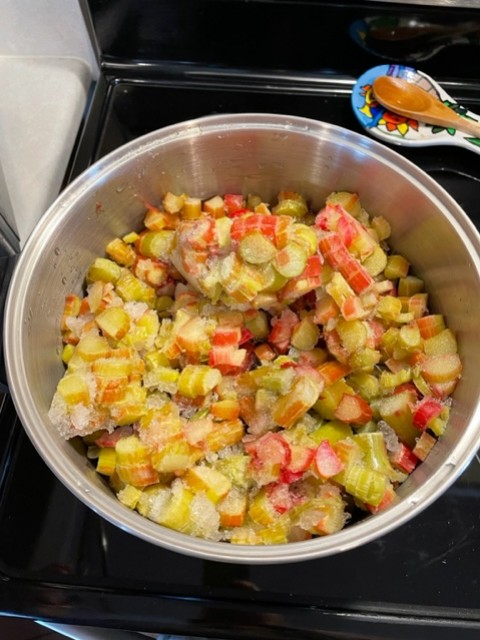
My sister was emptying her freezer a couple weeks ago and came across all the frozen rhubarb she hadn't used in crumbles over the winter. 24 cups worth as a matter of fact. So she called me and asked if I could use it.
Of course, I said yes, completely ignoring the fact that I had my own rhubarb in my own freezer.
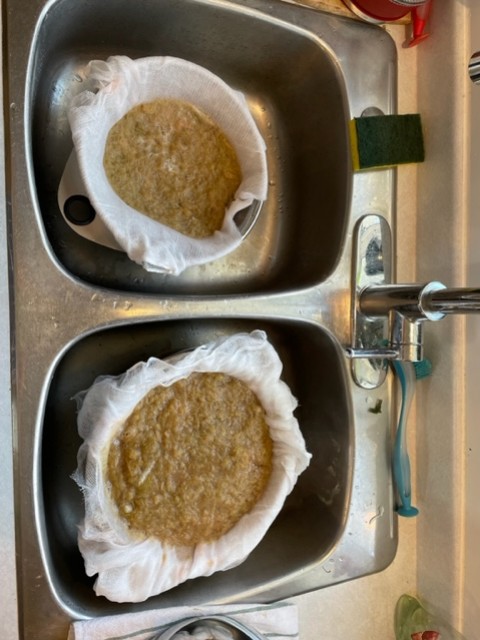
Frozen fruit and veggies can still be canned. In this case, 24 cups of rhubarb was enough for a double batch of the Sunshine Rhubarb Concentrate in the Bernardin Complete Book of Home Preserving in Canada (in the US it's the Ball Complete Book of Home Preserving.) Rhubarb concentrate has the same tart, tangy sensation as a good lemonade, but rhubarb-flavoured. It's a little different but delicious in its own way.
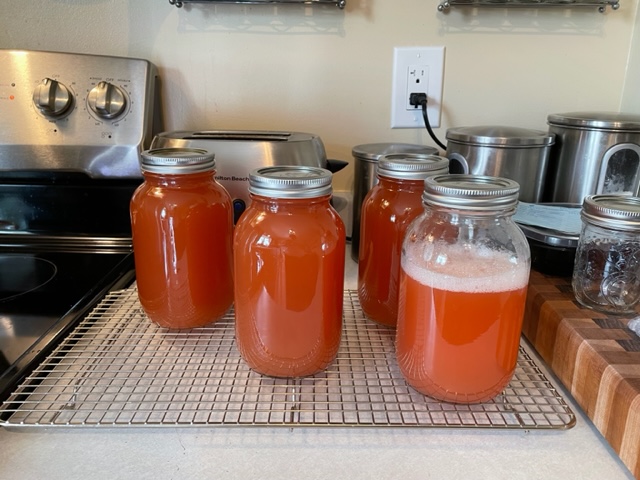
This was also an easy recipe to start with to get back into the swing of things as this year's rhubarb patch has already begun sprouting.
Pro-tip (learned the hard way): rather than cutting your rhubarb into pieces by hand, use the slicer function on a food processor and zip right through them. You'll be mashing them anyway.
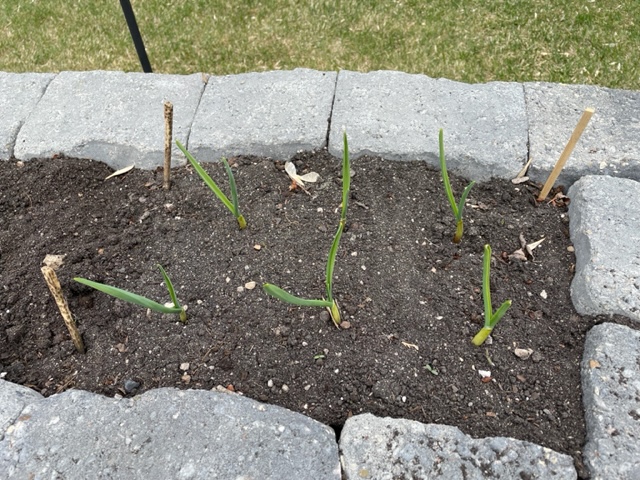
Success at last. In October 2021, we planted some garlic cloves in a garden box after the first frost. That ended up being the Winter that Would Not End, followed by the Spring of Eternal Rains. When we could finally check the box, the bulbs had rotted in the ground.
In October 2022, we tried again. We planted six bulbs in a different garden box, and a further 5 in an in-ground flower bed.
We now have 11 garlic sprouts! The in-ground bed is not great soil, or well drained, and they are about 2 weeks behind these ones. We hope to improve the soil this summer and do all our planting in that bed next fall, to free up this raised bed for herbs and flowers.
This is our first year of homegrown garden. I understand that the scapes (the onion type shoots on top) can be cooked or dehydrated, so we are looking forward to trying out some new recipes for those.
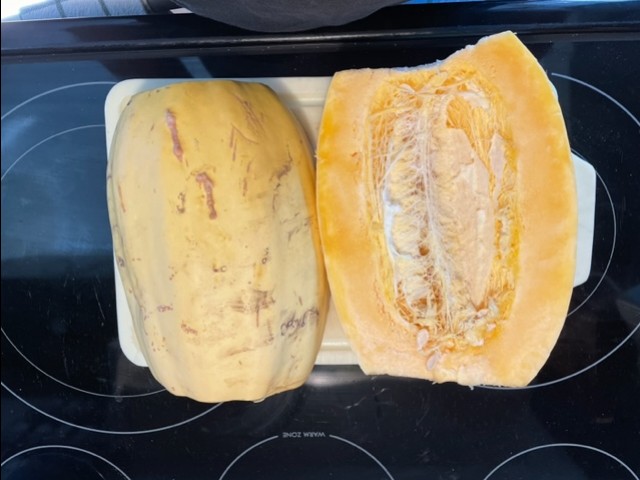
This spaghetti squash has been sitting in our cold room for six months as was just as tasty as it would have been if we'd eaten it the day we picked it. The scars and discolouration on the rind occurred while it was growing, so they can be disregarded. As long as the skin is firm and uncut when you put it away, and you check on them regularly (like monthly) to ensure they haven't started to spoil, a squash will last months in a cold room with no effort from you. A single vine can easily produce two to five squashes (2-5 meals), making it a productive garden option.
This spaghetti squash was about 5 pounds, more than enough to form the base for a large meal for four people. Scoop out the pulp and the seeds, rub some cooking oil, salt, and pepper into the flesh, turn upside-down on a baking tray, and bake for 1 hour at 350F. Then scrape out the flesh top to bottom with a fork to achieve the long "spaghetti" strands. You can also separate the seeds from the pulp, dry some for next year's planting, and bake the rest for 15 minutes at 400F. (Lightly spray with oil, sprinkle with salt and other spices - a little paprika and chilli powder is my favourite. Eat the whole thing, shells included, like you would pumplkin seeds.
Butternut squash is another personal favourite. With average-sized ones coming in at about 3 lbs, it is a solid vegetable. Treat the minimal pulp and seeds the same way. Because it does not have the fibrous strands of the spaghetti squash, you can easily peel it, then slice into 1/4" (1cm) slices, brush lightly with oil and bake on a flat pan at 350F for about 35 minutes. Butternut is a sweeter squash, so some people like to sprinkle it with cinnamon and brown sugar. I prefer salt, pepper, and a little oregano and basil. If you cook it plain, you can also turn it into butternut squash soup.
Squashes are full of vitamins, fibre, and are good for hydration. It's also a hot and filling meal to put in your stomach. But like most vegetables, it has a very low caloric value (45 cal per 100 gr) so it will fill you up in a healthy way, but it won't give you much energy if you are eating it as part of a survival diet.
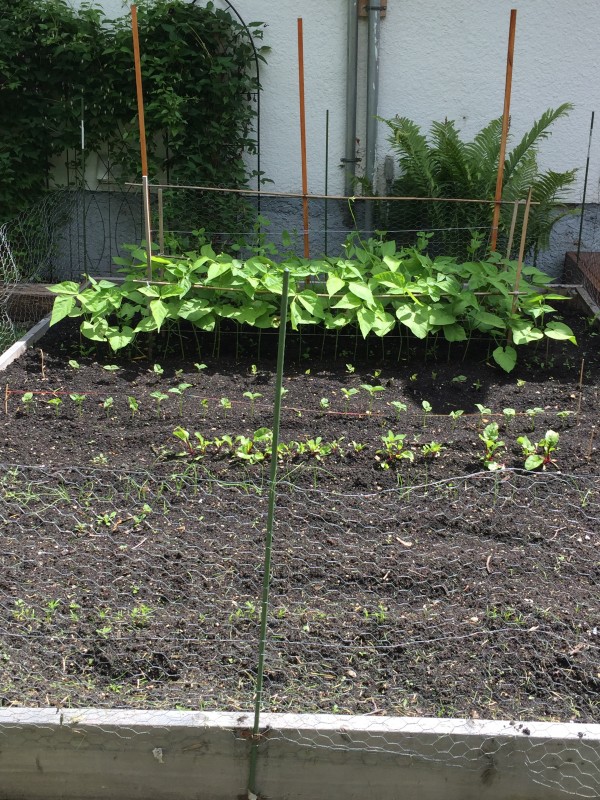
Whether you have a small 8' x 10' plot like this one, or a 25' x 50' victory garden, the time to plan is before you start to plant. We're going to start our tomato plants next week, and we need to know how many seedling will be optimal for what we intend to eat and preserve, and where we should plant them for maximum yield. Because of their height, we know they can't go at the east end of the garden, or along the south side, because they'll block out all the sun. We need to put the potatoes on the edge because those will be the last to be dug up in the fall and we want to keep them out of the way. The corn will be tall, and we will have to balance that against the staked beans. Then we need to figure out the low rows of carrots, onions, beets and greens.
I personally prefer to use graph paper, but if I found a computer program I liked, I'd happily use that.
Happy planning!
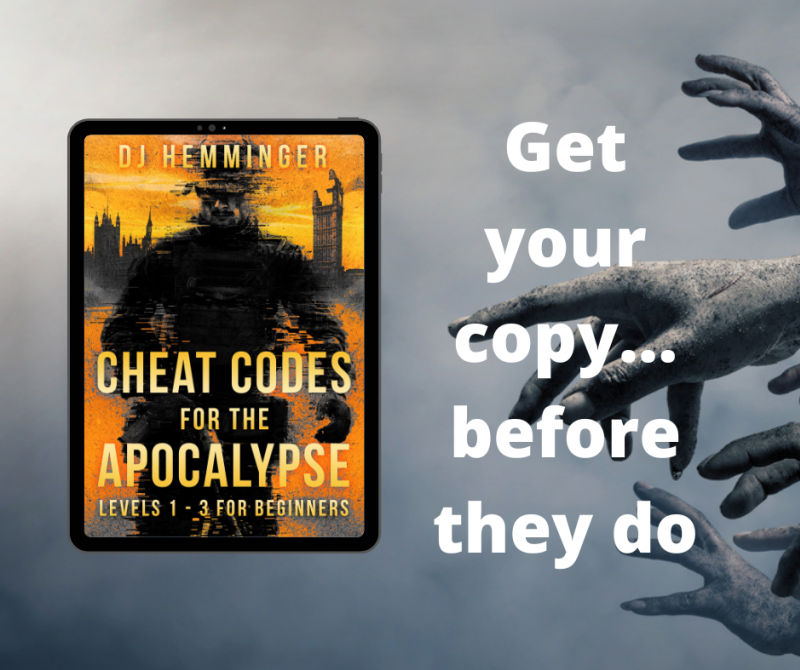
Thanks for spreading the word about "Cheat Codes for the Apocalypse Levels 1-3 for Beginners"! Those free copies are flying off the digital Amazon Kindle shelves. Don't forget that although the sale ends today, Kindle Unlimited subscribers can read it at any time.
And once you're finished with it, dive into the workbook (also free on Kindle Unlimited!)

Hey, friends, if you have tried the sample of CHEAT CODES FOR THE APOCALYPSE LEVELS 1-3 FOR BEGINNERS but wasn't sure if the book was for you, now's your chance to download it for *FREE* on Amazon/Kindle. That's right, zero cost, zero strings, a free book. Tell your friends!
(If you find this sale late, remember that Kindle Unlimited subscribers can read it and the Cheat Codes Workbook for free while it's enrolled in the program.)

As we trudge through the fourth month of a Manitoba winter, the stir-craziness starts to make itself known. We're fighting it by tackling the basement for a long overdue purge.
The problem with being prepared is that you want to be prepared for anything and everything. For most of us, that's not realistic. Stuff takes up space, and you can only keep so much on hand. Camping, gardening, hunting, communications, security, and every other type of gear would fill my entire basement, and I'm one of the lucky ones who has a basement.
But before I can begin to acquire even a fraction of what I should have on hand, I need some place to store it. Which means decluttering, purging, sorting, or whatever you want to call it.
We've been doing a little here and a little there, but we are specifically trying to open up some space in the basements, so the is going to be a hard weekend, where we have to honestly answer "am I ever going to use this item again?" As much as I'd like to think that I will eventually read the classics, I know I'm going to have a box of Dickens and Hardy and Dumas hardcovers to give away come Monday. Plus three lawnchairs (because nobody needs more than six), that extra lamp, and the box of stuffed animals from my childhood room that has't been opened in the last two decades.
Some will be trash, some will be donated, and some we'll try to sell. We'll reinvest those funds in something actually worth keeping.
Then we'll tackle the laundry room/workshop.
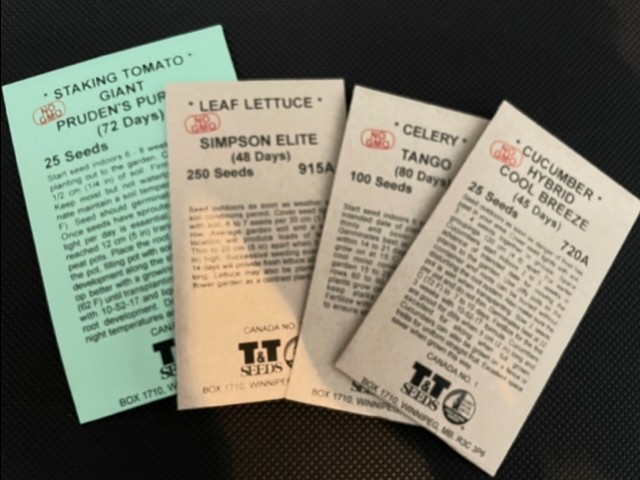
I'm very excited that we got to pick up our seeds this week. We only have to buy seeds about every 3 years, because that's how long a packet lasts us. We save whatever seeds we can - we have beans, peppers, winter squash and tomatoes. But I cannot get seedy summer squashes like cucumber or zucchini seeds to dry properly, so for now we just buy new ones and I'll try again in the fall.. Then there are the really difficult ones, like celery, lettuce, onions, carrots, and beets. They will go to seed naturally, but it's a pain fighting with them. I prefer not to fight with Mother Nature - she tends to win.
We get some of our seeds from a local seed supplier - T & T seeds, because they are very good for selling stuff that will grow in our region. But the standard seeds you buy at a store (Hello, Mackenzie Seeds from Canadian Tire) are excellent too. In fact, we prefer their zucchini seeds.
It's still a little early to start, although you are good for planting onions from seed in February. We're holding off till March to plant our peppers and celery.
Happy 2023 growing season!
CHILI
1 can red kidney beans
1 can white kidney beans
1 can black beans
1 can brown beans* or pinto beans
1 can sliced mushrooms
1 can kernel corn
1 can crushed tomatoes
2 tbsp dried onion flakes
3-4 tbsp. chili powder
1 tsp dried crushed red pepper seeds
1-2 tbsp dehydrated pepper slices
1 tsp salt
Mix all ingredients in large pot or slow cooker. Cook on burner for 1.5 hours on low heat, stirring often. If using a slow cooker, put on “Low” for 4 hours.
*make sure they aren't pork and beans if going for a full-vegan meal
I've had this cold since January 3rd. Everybody I've spoken to says it hangs around for two to three weeks, and it's super tough to shake. I'm desperately trying not to infect my partner, but I'm not overly hopeful.
What can I do about it? Not much. He stopped in at Safeway. They were completely - completely - sold out of cough medicine. They did have pineapple juice, which is supposed to have a natural cough suppressant, so we do have some of that. And they had tissues. Seriously, after four days of blowing my nose, I've decided that whoever invented Kleenex with Lotion deserves to be nominated for sainthood.
I've been wiping down everything I touch on a daily basis. I got rid of my old lip balms and started a new one. My toothbrush is getting an alcohol bath till I kick this, and then I'll start a new one. I've gone for a walk outside and the fresh air was amazing, so I'm opening windows and am giving the house a quick airing out.
I'm doing way more laundry than normal, washing night shirts and towels and sheets to try to give my body less infected surfaces to fight.
But it's a cold. What can you do?
Be safe out there.









